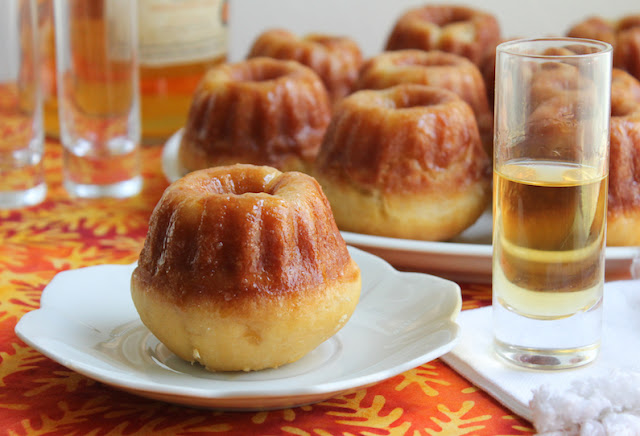This month my Bundt Bakers group is recreating Italian sweets as Bundts. I could only think of two off the top of my head, panna cotta and tiramisu so clearly some research into Italian dessert recipes was going to be necessary. In my typical fashion, I used Google Translate to figure out what “dessert” and “recipe” are in Italian, then I use those terms to search.
Sure, I could probably find some authentic recipes in English but what fun is that? I know I’m weird but I find it amusing to search in other languages, even ones I don’t speak. It adds another layer of challenge.
Babà Napoletano al Rum Bundtlettes
This recipe is adapted from one on Misya.info, a food diary written by a Neapolitan who learned to cook from her mother and grandmother. She assures her readers that babà is a typical sweet of the Neapolitan tradition, perhaps it is even the typical Neapolitan dessert par excellence. I was charmed by her write-up, published on the very day she was getting married.Ingredients
For the dough:
1 teaspoon dry active yeast
2 tablespoons warm milk
2 tablespoons sugar plus extra for pan
4 large eggs, at room temperature
3/4 teaspoon salt
3 1/4 cups or 406g flour
1/2 cup or 113g butter, at room temperature, plus extra for pan
For the rum syrup:
1 1/4 cup or 250g sugar
1/2 cup or 120ml water
1/2 cup or 120ml dark rum, divided
Zest 1 small orange (peel off just the orange part, not the white pith)
Method
In the bowl of your stand mixer, combine the yeast with the sugar and warm milk. Leave to prove for a few minutes. The yeast should start bubbling.
If the yeast is active, add in the eggs, butter and salt and half of the flour.
Beat for about 10 minutes on medium speed, scraping the bowl down with a spatula occasionally.
Now add in the rest of the flour and beat until the dough is stretchy and pulls away from the sides of the bowl. Cover the bowl with a damp cloth and leave the dough to rise in a warm place for about an hour.
Turn the dough out onto a clean buttered surface and knead the dough again. Divide it into 12 pieces. Tuck them into neat balls.
Butter and sugar your bundtlette pan.
Arrange the dough evenly inside the prepared pan, by making a hole in each ball and lowering it into the bundlette holes.
Cover lightly with greased cling film and leave it a warm place to rise for 30 minutes.
When rising time is almost up, preheat your oven to 350°F or 180°C.
Bake your babàs for 20-25 minutes or until they are golden and well risen.
Meanwhile, put the sugar, water and orange peel in a small pot with half of the rum and bring the mixture to a rolling boil for a few minutes. Remove from the heat then add in the rest of the rum and stir.
Discard the orange peel.
When the babàs are baked, remove the pan from the oven. Remove each babà from the pan and spoon in about three teaspoons of syrup into each hole. Carefully place the babà back in the hole so it can absorb the syrup.
Prick the tops of the warm babàs and brush the syrup on slowly so it has time to soak in.
Keep brushing the syrup on the top and occasionally adding a bit more to the pan holes until all the syrup has been absorbed.
Turn the babàs out onto a serving platter. (I must confess that I had to trim just the tiniest bit off the bottom so they'd stand up straight.) The Italian recipe doesn’t mention this but you can serve the babàs with extra rum or even vanilla ice cream and rum. They make a wonderful dessert!
Enjoy!
Check out the rest of the wonderful Italian sweets recreated as Bundts below. Many thanks to our host Patricia of Patyco Candybar for this fun theme.
- Babà Napoletano al Rum Bundtlettes from Food Lust People Love
- Frosted Tiramisu Bundt Cake from Making Miracles
- Tiramisu Cake from A Day in the Life on the Farm
- Torta al Limoncello With Homemade Limoncello from Sneha's Recipe
- Torta Caprese al Limoncino from Patyco Candybar
- Spumoni Bundt Cake from Palatable Pastime






































